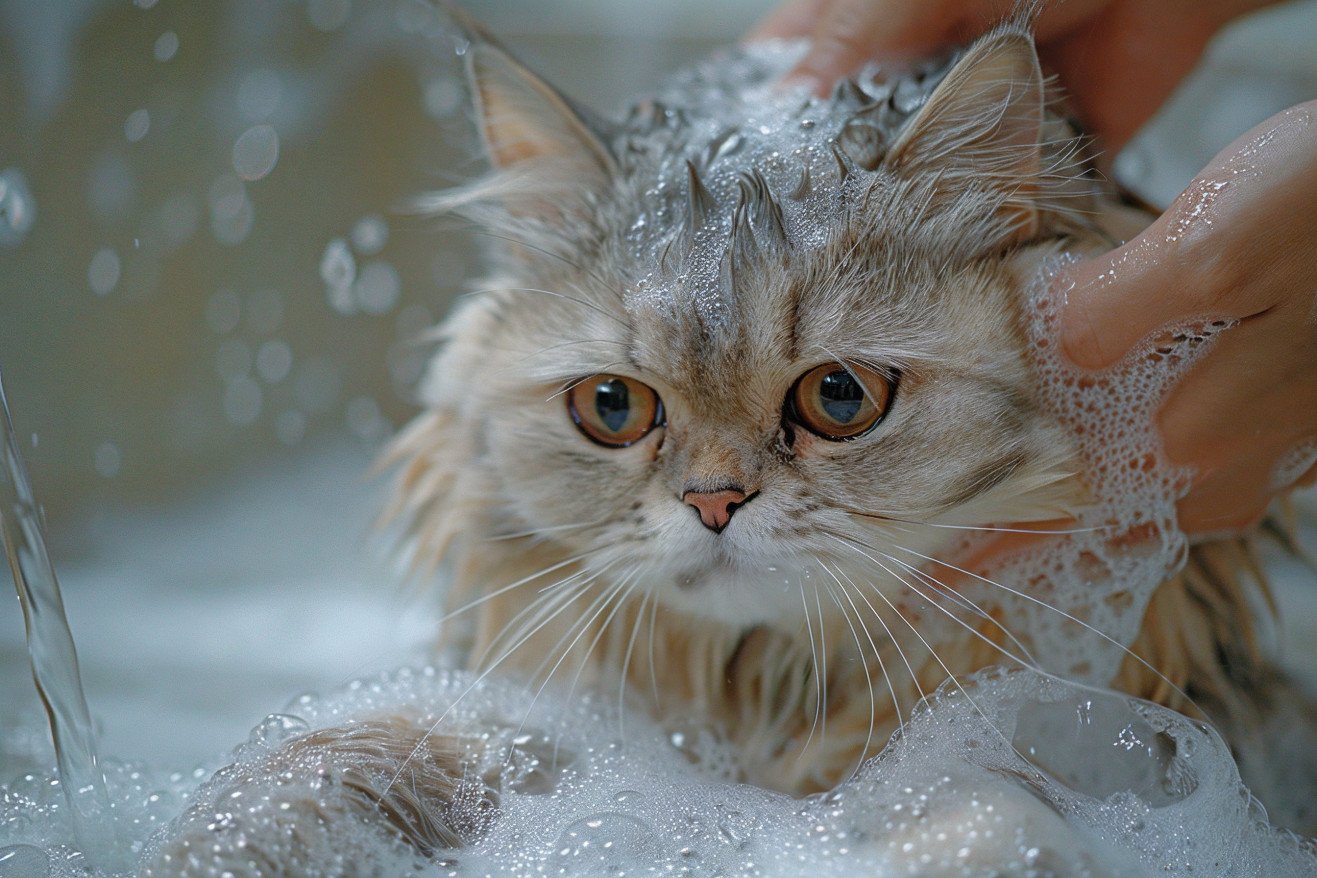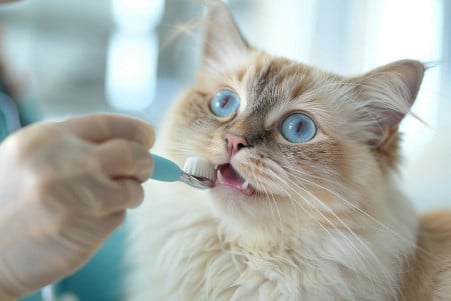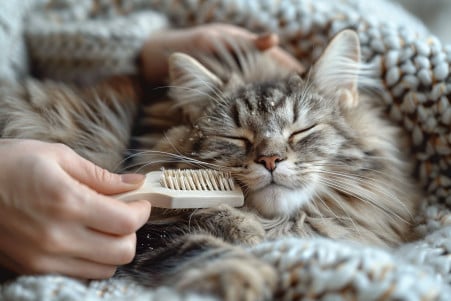How to Bathe and Groom Your Cat the Right Way? Best Practices
3 April 2024 • Updated 2 April 2024

Even if your cat is a long-haired breed or is known for keeping itself clean, every cat can benefit from a little extra grooming. Grooming your cat properly starts with brushing to remove excess hair and then moves on to bathing with a cat-safe shampoo to ensure their coat stays clean and healthy. For short-haired cats, you may be able to get away with using a damp cloth to wipe them down between baths.
While the idea of bathing a cat may be intimidating, we will go over the best practices to ensure that you and your cat can have a stress-free and safe experience. Based on advice from veterinarians and professional groomers, we will go over the key techniques for brushing, bathing, drying, and maintaining your cat's coat in between baths. With a little bit of work and a lot of patience, regular grooming can be a great way to bond with your cat and help them stay happy, healthy, and clean.
How should you bathe and groom your cat?
Getting Ready for Bath Time: What You Need and More
The key to a successful cat bath is to be well-prepared so that you can make the experience as stress-free as possible for both you and your cat. This starts with getting the right supplies, which include a cat-safe shampoo, large towels, a non-slip mat for the tub or sink, and your cat's favorite treats for positive reinforcement. In addition, as vet professionals at Preventive Vet point out, trimming your cat's nails a day or two before the bath can help prevent accidental scratches.
After you've gathered your supplies, make sure to brush your cat thoroughly to remove any loose fur and to help prevent clogs in the drain. The ASPCA also suggests that you find a quiet, low-traffic location, such as a bathroom or laundry room, to bathe your cat. You may also want to use pheromone diffusers or calming supplements to help lower your cat's anxiety. These steps will help you set up a safe, low-stress environment for the bath.
If you've prepared properly and are ready to be patient and gentle, bathing your cat can be a simple way to bond. Now that you've brushed your cat and trimmed their nails, you're ready to introduce them to the bathing area.
How to Bathe a Cat: A Step-by-Step Tutorial
Before you start the bath, make sure to introduce your cat to the bathing area and let them explore. BeChewy explains that this will help keep your cat relaxed and happy throughout the process.
When you're ready to start the bath, make sure the water is lukewarm and slowly wet your cat's body, making sure to avoid their face, ears, and nose. The ASPCA suggests using a small amount of cat-safe shampoo and working it into a light lather, focusing on areas that get dirty and oily, like the belly and paws.
Once you've shampooed your cat, WebMD recommends rinsing them thoroughly to make sure you get rid of all the shampoo, which can irritate their skin if it's left behind. Then, wrap your cat in a towel and pat them dry, being careful not to rub them or cause them any discomfort.
By taking your time and being as gentle and patient as possible, you can help ensure that both you and your cat have a positive experience during bath time.
Nail Trimming: A Key Component of Cat Grooming
According to PetMD, it's important to trim your cat's nails every 2-4 weeks to prevent them from growing too long, which can cause your cat pain and lead to unwanted scratching. To make sure you get a good, clean cut, you should use cat nail clippers or nail scissors, which are made specifically for cutting nails, according to The Humane Society.
You should also be careful not to cut the quick, the pink part of the nail that contains blood vessels and nerves, which can cause pain and bleeding. The Ontario SPCA and Humane Society recommends getting your cat used to having their paws touched and the sound of the clippers and other tools you'll use to trim their nails. You can also help your cat get used to the process by giving them treats and praise after you trim their nails. This will help them associate the experience with positive things, making it more enjoyable for them.
Ear Cleaning: How Often and How to Do It Safely
While cats don't typically need their ears cleaned often, occasional ear cleaning may be necessary to help prevent infections or mite infestations, says Zoetis Petcare. Signs that your cat may need their ears cleaned include excessive scratching, head shaking, odor, or visible debris or wax buildup.
When cleaning your cat's ears, it's important to use a vet-recommended ear cleaning solution and cotton balls or gauze pads, but not cotton swabs, which can push debris further into the ear canal, according to PetMD. Gently fold back your cat's ear and apply a few drops of the cleaning solution, massaging the base of the ear to help loosen debris. Then, use a clean cotton ball or gauze pad to wipe away any excess solution and debris, being careful not to put anything into the ear canal.
Keeping up with your cat's regular grooming, including checking their ears, can help make sure they stay healthy and comfortable between full grooming sessions.
How to Keep Your Cat's Coat Healthy
Regular brushing is key to keeping your cat's coat healthy between grooming appointments, especially for long-haired cats. Purina explains that brushing removes dirt and loose hair, stimulates the skin, and helps to distribute natural oils that keep the coat healthy and waterproof.
For short-haired cats, the ASPCA recommends using a metal comb and natural-bristle brush once a week. Long-haired cats should be brushed daily with a steel comb to prevent matting. WebMD suggests using a slicker brush or grooming glove to gently remove loose hair and distribute oils.
In between baths, Purina explains that dry shampoo or waterless grooming products can be used for touch-ups. In addition, make sure your cat has scratching posts and pads to help them naturally shed their claws and keep their paws healthy.
Make sure to keep an eye on your cat's coat and skin for any changes, including excessive shedding, bald patches, or signs of skin irritation. If you notice anything unusual, the ASPCA recommends contacting your vet to rule out any medical issues.
Conclusion: The Benefits of Regular Cat Grooming
Grooming is important for a cat’s well-being, and it can help ensure that your pet is healthy, happy, and looking and feeling their best. In addition, grooming practices like bathing, nail clipping, and ear cleaning can help you bond with your cat.
By taking the time to learn and prepare, and by using the right equipment, grooming can be a positive experience for both you and your cat. If you’re having trouble, don’t hesitate to ask your vet or a professional groomer for help.


